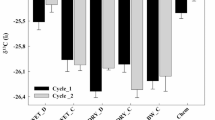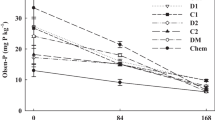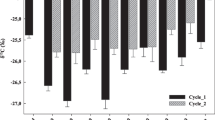Abstract
In this work a residue of dry-batch anaerobic digestion (DB) from the organic fraction of municipal solid waste, its composted homologous (CDB), and a municipal solid waste compost (MSWC) were characterized for their main physico-chemical traits and biological stability [oxygen uptake rate (OUR)]. These were then compared in soil incubations at 200 mg N kg−1, to assess carbon (C) and nitrogen (N) mineralization. The products’ nitrogen apparent recovery fraction (ARF) was assessed in a pot trial on Italian ryegrass. DB showed the highest OUR, followed by CDB and the more stable MSWC: 161.7; 20.7 and 5.7 mmol O2 kg−1 VS h−1, partially in agreement with the potentially mineralizable C pools in soil: 58.4; 16.6 and 19.5 % and their kinetics (k, 0.1906; 0.1405 and 0.1377 day−1). Composting greatly reduced the total carbon dioxide (CO2) emissions from 7,950 to 3,449 mg kg−1 in DB and CDB, even higher than MSWC (1,936 mg kg−1). After intense N-immobilization in soil (−22.3 %), DB finally reduced the gap (−6.9 %), also having a positive ARF (5.0 %), while CDB had greater N-immobilization (−12.9 %) and a negative ARF (−3.4 %). MSWC showed 3.8 % N-mineralization, and an intermediate ARF (2.7 %). The management of DB for plant nutrition therefore seems difficult since DB can furnish nitrogen not easily synchronizable with plant growth due to its release pattern characterized by initial immobilization. Composting increased stability but amplified N-immobilization due to the high C:N ratio of the bulking agent. A prolonged and more balanced composting process can reduce this restriction, aligning CDB with MSWC.



Similar content being viewed by others
References
Council directive 2009/28/EC of the European Parliament and of the Council of 23 April 2009. Official Journal L 140/16, 05/06/2009
EBA: European Biogas Association. Biogas report (2012). http://www.european-biogas.eu/. Last accessed 03 Nov 2013
Herrmann, A.: Biogas production from maize: current state, challenges and prospects. 2. Agronomic and environmental aspects. Bioenerg. Res. 6, 372–387 (2013)
Council Directive 99/31/EC of 26 April 1999. Official Journal L 182, 16/07/1999
Edelmann, W., Schleiss, K., Joss, A.: Ecological, energetic and economic comparison of anaerobic digestion with different competing technologies to treat biogenic wastes [J]. Water Sci. Technol. 41, 263–273 (2000)
De Baere, L., Mattheeuws, B.: State of the art of anaerobic digestion of municipal solid waste in Europe. Proceedings of the International Conference on Solid Waste 2011—Moving Towards Sustainable Resource Management, Hong Kong SAR, P.R. China, 2–6 May 2011
Odlare, M., Pell, M., Svensson, K.: Changes in soil chemical and microbiological properties during 4 years of application of various organic residues. Waste Manage. 28, 1246–1253 (2008)
Gunnarsson, A., Bengtsson, F., Caspersen, S.: Use efficiency of nitrogen from biodigested plant material by ryegrass. J. Plant Nutr. Soil Sci. 173, 113–119 (2010)
Bachmann, S., Wentzel, S., Eichler-Löbermann, B.: Codigested dairy slurry as a phosphorus and nitrogen source for Zea mays L. and Amaranthus cruentus L. J. Plant Nutr. Soil Sci. 174, 908–915 (2011)
Tiessen, H., Cuevas, E., Chacon, P.: The role of soil organic matter in sustaining soil fertility. Nature 371, 783–785 (1994)
Balesdent, J., Chenu, C., Balabane, M.: Relationship of soil organic matter dynamics to physical protection and tillage. Soil Till. Res. 53, 215–230 (2000)
Bertora, C., Alluvione, F., Zavattaro, L., van Groenigen, J.W., Velthof, G., Grignani, C.: Pig slurry treatment modifies slurry composition, N2O, and CO2 emissions after soil incorporation. Soil Biol. Biochem. 40, 1999–2006 (2008)
Pezzolla, D., Bol, R., Gigliotti, G., Sawamoto, T., López, A.L., Chadwick, D.: Greenhouse gas (GHG) emissions from soil amended with digestate derived from anaerobic treatment of food waste. Rapid Commun. Mass Spectrom. 26, 2422–2430 (2013)
Fouda, S., von Tucher, S., Lichti, F., Schmidhalter, U.: Nitrogen availability of various biogas residues applied to ryegrass. J. Plant Nutr. Soil Sci. 176, 572–584 (2013)
Alburquerque, J.A., de la Fuente, C., Bernal, M.P.: Chemical properties of anaerobic digestates affecting C and N dynamics in amended soils. Agr. Ecosyst. Environ. 160, 15–22 (2012)
de la Fuente, C., Alburquerque, J.A., Clemente, R., Bernal, M.P.: Soil C and N mineralisation and agricultural value of the products of an anaerobic digestion system. Biol. Fertil. Soils 49, 313–322 (2013)
Galvez, A., Sinicco, T., Cayuela, M.L., Mingorancem, M.D., Fornasier, F., Mondini, C.: Short term effects of bioenergy by-products on soil C and N dynamics, nutrient availability and biochemical properties. Agr. Ecosyst. Environ 160, 3–14 (2012)
Fangueiro, D., Coutinho, J., Borges, L., Cabral, F., Vasconcelos, E.: Nitrogen and carbon availability of liquid and solid fractions of pig slurry obtained using different separation technologies. Biol. Fert. Soils 1–9 (2013). doi:10.1007/s00374-013-0861-z
Svensson, K., Odlare, M., Pell, M.: The fertilizing effect of compost and biogas residues from source separated household waste. J. Agr. Sci. 142, 461–467 (2004)
de Boer, H.C.: Co-digestion of animal slurry can increase short-term nitrogen recovery by crops. J. Environ. Qual. 37, 1968–1973 (2008)
Bolzonella, D., Innocenti, L., Pavan, P., Traverso, P.: Semi-dry thermophilic anaerobic digestion of the organic fraction of municipal solid waste: focusing on the start-up phase. Bioresour. Technol. 86, 123–129 (2003)
Di Maria, F., Gigliotti, G., Sordi, A., Micale, C., Zadra, C., Massaccesi, L.: Hybrid solid anaerobic digestion batch: biomethane production and mass recovery from the organic fraction of solid waste. Waste Manage. Res. (2013). doi:10.1177/0734242X13477902
Grigatti, M., Dios Pérez, M., Blok, J.W., Ciavatta, C., Veeken, A.: A standardized method for the determination of the intrinsic carbon and nitrogen mineralization capacity of natural organic matter sources. Soil Biol. Biochem. 39, 1493–1503 (2007)
Cayuela, M.L., Velthof, G.L., Mondini, C., Sinicco, T., van Groenigen, J.W.: Nitrous oxide and carbon dioxide emissions during initial decomposition of animal by-products applied as fertilisers to soils. Geoderma 157, 235–242 (2010)
Veeken, A., Blok, W., Moolenaar, S., Grigatti, M.: Standardized determination and classification of compost organic matter stability. In: Proceedings of the 2nd BOKU Waste Conference, 16–19 April 2007, Vienna, Austria
Grigatti, M., Di Girolamo, G., Chincarini, R., Ciavatta, C., Barbanti, L.: Potential nitrogen mineralization, plant utilization efficiency and soil CO2 emissions following the addition of anaerobic digested slurries. Biomass Bioenerg. 35, 4619–4629 (2011)
Shu-guang, L.U., Tsuyoshi, I., Masao, U., Masahiko, S.: Start-up performances of dry anaerobic mesophilic and thermophilic digestions of organic solid wastes. J. Environ. Sci. 19, 416–420 (2007)
Yenigün, O., Demirel, B.: Ammonia inhibition in anaerobic digestion: a review. Process Biochem. 48, 901–911 (2008)
Ponsá, S., Gea, T., Alerm, L., Cerezo, J., Sanchez, A.: Comparison of aerobic and anaerobic stability indices through a MSW biological treatment process. Waste Manage. 28, 2735–2742 (2008)
Mata-Alvarez, J., Mac, S., Llabrés, P.: Anaerobic digestion of organic solid wastes. An overview of research achievements and perspectives. Bioresour. Technol. 74, 3–16 (2000)
Decreto Legislativo 29 aprile 2010, n.75: Riordino e revisione della disciplina in materia di fertilizzanti, a norma dell’articolo 13 della legge 7 luglio 2009, n. 88. Gazzetta Ufficiale n. 121 del 26 maggio 2010
Bernal, M.P., Navarro, A.F., Sanchez-Monedero, M.A., Roig, A., Cegarra, J.: Influence of sewage sludge compost stability and maturity on carbon and nitrogen mineralization in soil. Soil Biol. Biochem. 30, 305–313 (1998)
Bernal, M.P., Sánchez-Monedero, M.A., Paredes, C., Roig, A.: Carbon mineralization from organic wastes at different composting stages during their incubation with soil. Agric. Ecosys. Environ. 69, 175–189 (1998)
Author information
Authors and Affiliations
Corresponding author
Rights and permissions
About this article
Cite this article
Grigatti, M., Cavani, L., Marzadori, C. et al. Recycling of Dry-Batch Digestate as Amendment: Soil C and N Dynamics and Ryegrass Nitrogen Utilization Efficiency. Waste Biomass Valor 5, 823–833 (2014). https://doi.org/10.1007/s12649-014-9302-y
Received:
Accepted:
Published:
Issue Date:
DOI: https://doi.org/10.1007/s12649-014-9302-y




